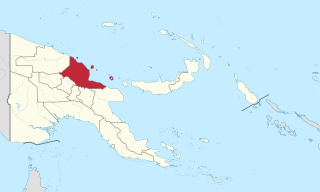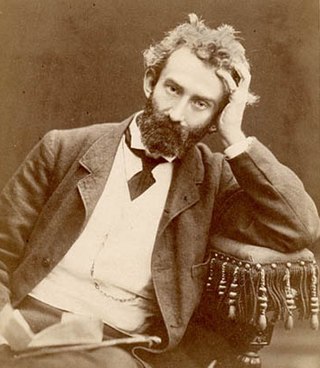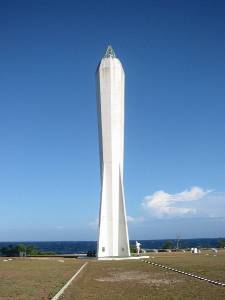Related Research Articles
Indo-Pacific is a hypothetical language macrofamily proposed in 1971 by Joseph Greenberg and now believed to be spurious. It grouped together the Papuan languages of New Guinea and Melanesia with the languages of the Andaman Islands and, tentatively, the languages of Tasmania, both of which are remote from New Guinea. The valid cognates Greenberg found turned out to be reflexes of the less extensive Trans–New Guinea family. Recently the Kusunda language, which is generally seen as a language isolate, is also included in the Indo-Pacific proposal. Greenberg did not include "Australian" in his original 1971 proposal.

Madang is a province of Papua New Guinea. The province is on the northern coast of mainland Papua New Guinea and has many of the country's highest peaks, active volcanoes and its biggest mix of languages. The capital is the town of Madang.

Nicholas Miklouho-Maclay was a Russian Imperial explorer. He worked as an ethnologist, anthropologist and biologist who became famous as one of the earliest scientists to settle among and study indigenous people of New Guinea who had never seen a European.

Madang is the capital of Madang Province and is a town with a population of 27,420 on the north coast of Papua New Guinea. It was first settled by the Germans in the 19th century.
Motu is a Central Papuan Tip language that is spoken by the Motuans, an indigenous ethnic group of Papua New Guinea. It is commonly used today in the region, particularly around the capital, Port Moresby.
The Piawi languages are a small family of Papuan languages spoken in the Schraeder Range of the Madang Highlands of Papua New Guinea that had been part of Stephen Wurm's Trans–New Guinea proposal. They are now connected to the Arafundi and Madang languages.
The Mindjim languages are a small family of closely related languages spoken in the Mindjim River area of Papua New Guinea. They were linked with the Rai Coast languages in 1951 by Arthur Capell in his Madang family, but separated out again by Timothy Usher.
The Rai Coast languages are a family of languages in the Madang stock of New Guinea.

The Madang or Madang–Adelbert Range languages are a language family of Papua New Guinea. They were classified as a branch of Trans–New Guinea by Stephen Wurm, followed by Malcolm Ross. William A. Foley concurs that it is "highly likely" that the Madang languages are part of TNG, although the pronouns, the usual basis for classification in TNG, have been "replaced" in Madang. Timothy Usher finds that Madang is closest to the Upper Yuat River languages and other families to its west, but does not for now address whether this larger group forms part of the TNG family.
Mauwake (Mawake), or Ulingan, is a Papuan language of Madang Province, Papua New Guinea. It is spoken in several villages along the north coast of Madang province, which lies in the north-east of Papua New Guinea.
Apalɨ (Apal), or Emerum, is a Papuan language of Madang Province, Papua New Guinea. Akɨ and Acɨ are two dialects that are quite different from each other.
Siroi (Suroi) is a Rai Coast language spoken in Madang Province, Papua New Guinea, and a local trade language. It is spoken in Kumisanger village, Astrolabe Bay Rural LLG, Madang Province.
Sam, or Songum, is a Madang language spoken in Madang Province, Papua New Guinea.
Bagupi is a nearly extinct Madang language of Papua New Guinea. The language is under pressure from neighboring large languages such as Garuh, and Tok Pisin, which is taking its toll. Spoken in the Madang Province of Papua New Guinea. Spoken at the headwaters of the Gogol River, west of Mabanob, northwest of Madang town. Very little is still known about this unique language situated in Papua New Guinea.
Ronji is a minor Austronesian languages of northern Papua New Guinea.
Mendeleev's clingfish is a species of fish in the family Gobiesocidae endemic to Madang Province in Papua New Guinea. This species is the only known member of its genus. This species was described in 2005 by Artem Mikhailovich Prokofiev, the type being collected near the village of Bongu in Madang Province from the research vessel Dmitrii Mendeleev, referred to in its specific name. The vessel was in turn named in hours of the Russian chemist Dmitrii Mendeleev (1834-1907), the creator of the most widely recognised periodic table.
Bongu may refer to:
Astrolabe Bay Rural LLG is a local-level government (LLG) of Madang Province, Papua New Guinea.
Yamben (Yaben) is a Trans–New Guinea language of Madang Province, Papua New Guinea. It was first documented by Andrew Pick in the 2010s and classified by Pick (2019) as a probable primary branch of Madang, though its precise classification is still pending further research. Although surrounded by Croisilles languages, Yamben is not one of them.
Proto-Trans–New Guinea is the reconstructed proto-language ancestral to the Trans–New Guinea languages. Reconstructions have been proposed by Malcolm Ross and Andrew Pawley.
References
- ↑ Bongu at Ethnologue (18th ed., 2015) (subscription required)
- ↑ https://mikluho-maclay.ru/en/russian-loan-words-in-the-indigenous-languages-of-papua-new-guinea/